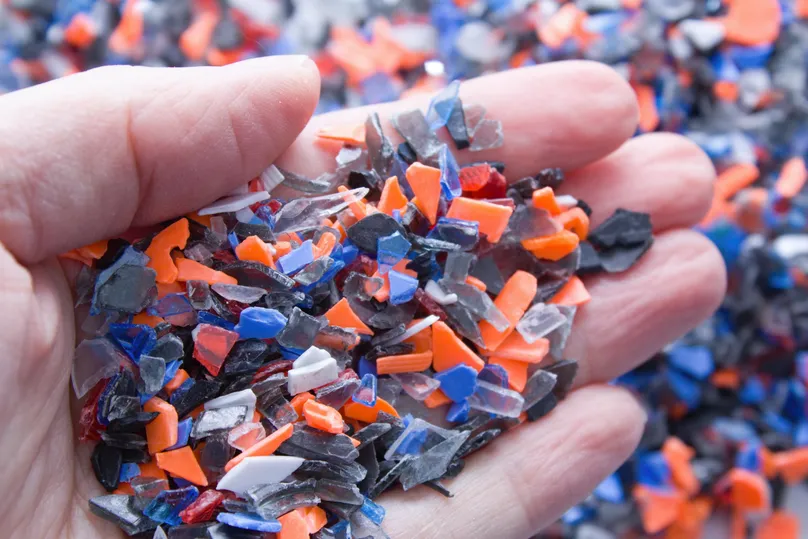Recycled plastic
In Australia, most of the plastic waste comes from packaging and some from built environment, automotive industry, and electrical and electronics applications. Commonly recyclable plastics from these sources include polyethylene terephthalate (PET), high-density polyethylene (HDPE), low-density polyethylene (LDPE), polyamide (PA) and polypropylene (PP). These recyclable plastics can be reprocessed into recycled plastic products (e.g. geosynthetics, plastic granules) and repurposed for use in infrastructure.
How is it processed?
In 2017, Australia had a total of 76 reprocessing facilities for waste plastics. Of those, 4 were in Western Australia, 24 in Victoria, 20 in New South Wales, 12 each in Queensland and South Australian, and 2 each in Northern Territory and Tasmania.
The plastic recycling process typically involves sorting plastics by type, washing and shredding them, followed by melting and extruding the material into new recycled plastic products.
Environmental, health, and safety
The primary environmental, health and safety concerns regarding the use of recycled plastics in transport infrastructures include:
- health risks from fumes and emissions generated during plastic reprocessing
- presence of chemicals, additives, contaminants, and the generation of microplastics in recycled plastic
- migration or leaching of contaminants or microplastics into surrounding environments
While further research is still needed, current available research indicates that the risk of microplastics generation from recycled plastic-modified asphalt is comparable to business-as-usual polymer modified binders. Further, fumes and emissions assessment to date indicates the risk is neglible and below SafeWork limits.
Nevertheless, appropriate personal protective equipment should be worn to mitigate potential risks.
Applications
Efforts are already being made in Australia to repurpose recycled plastics in infrastructure. These include:
- manufacture plastic ancillary components
- noise wall (HDPE plastics with content limit up to 75%)
- railway sleeper (content limit up to 100%)
- plastic pipes (HDPE plastics with content limit up to 100%) - incorporate recycled plastics into bitumen and asphalt (content limit up to 6%)
- incorporate recycled plastics into geosynthetics such as geogrids and geotextiles
Specifications
Presently, Main Road Western Australia does not have specifications available to guide the use of recycled plastics in infrastructure applications.
The Public Transport Authority allows for the use of recycled plastic for pipes and fittings (not under trafficable areas) in:
- 8880-450-090: Specification - Design of Drainage for PTA Infrastructure
Benefits and challenges
Recycling plastics in infrastructure applications allows the industry to extract value from plastic waste that would otherwise be landfilled, while also contributing to the conservation of natural resources, reducing landfill, and minimising carbon emissions. However, one of the key challenges hindering wider adoption of recycled plastics in Australia is the lack of available standards or specifications to guide their use.
Previous use in Western Australia
Boral paved Arlington Way in Willetton for the City of Canning using a mix that incorporated the equivalent of 58,000 plastic water bottles, 316 tyres, and 37,500 lass bottles. Additionally, Boral used the same mix to pave a 250-metre-long project at Mofflin Avenue in Claremont, which included the equivalent of 48,000 plastic water bottles, 250 tyres and 31,000 glass bottles.

References
- Hall, B, Grenfell, J, Pandelidi, C, Yaghoubi, J, Chaudry, U, Lyons, M, O'Connor, G, Harrison, J & Feigen, D 2022, Best practice expert advice on the use of recycled materials in road and rail infrastructure: part A technical review and assessment.
- Hall, B, Grenfell, J, Pandelidi, C, Yaghoubi, J, Lyons, M, O'Connor, G, Harrison, J, Feigen, D & Xue, S 2022, Best practice expert advice on the use of recycled materials in road and rail infrastructure: part B sustainability impacts report.
- Arulrajah, A, Yaghoubi, E, Wong, Y.C & Horpibulsuk, S 2017, Recycled plastic granules and demolition wastes as construction materials: Resilient moduli and strength characteristics, Construction and building materials, 147, pp.639-647.
- ecologiQ 2022, Recycled materials in rail infrastructure reference guide, viewed 2 October 2024, <https://bigbuild.vic.gov.au/__data/assets/pdf_file/0010/646912/ECQ_Rail_Infrastructure_Recycled_Materials_Guide.pdf>.
- ecologiQ 2024, Recycled materials in road infrastructure reference guide, viewed 2 October 2024, <https://bigbuild.vic.gov.au/__data/assets/pdf_file/0011/646913/Recycled-Materials-in-Road-Infrastructure-Aug-2024.pdf>.
- NACOE 2024, Investigating the Use of Recycled Plastics in Safe, Sustainable Future Road Infrastructure, viewed 14 October 2024, <https://www.youtube.com/watch?v=jihwggXSfWM>.
The road to recycling in METRONET
